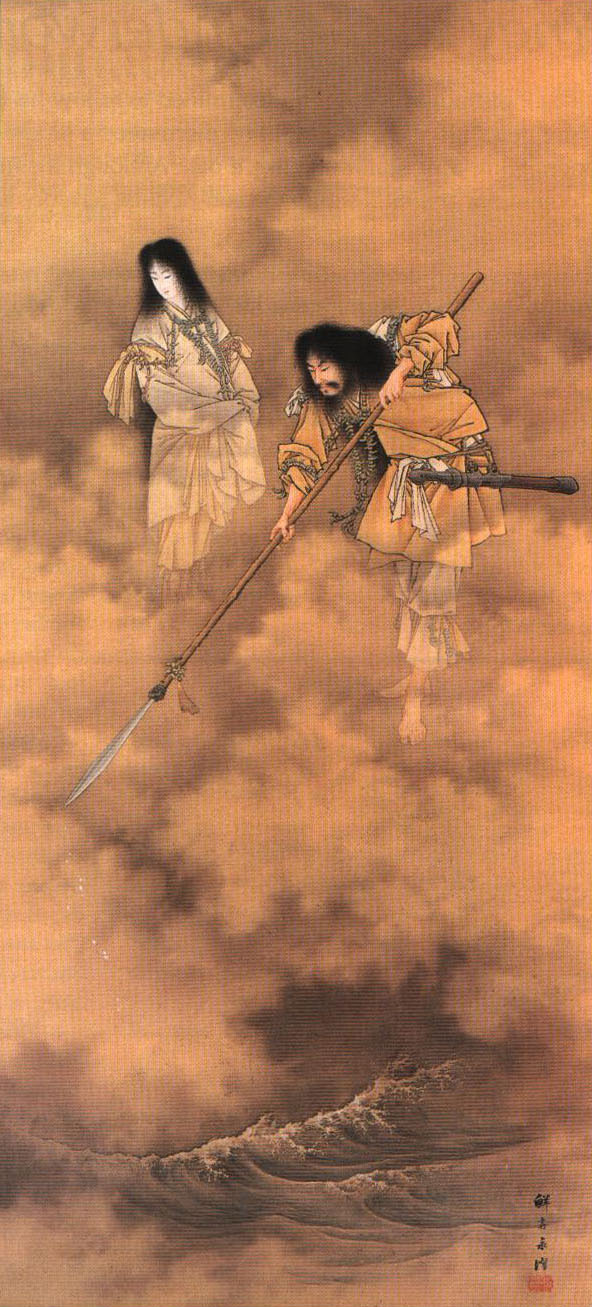
This article includes a list of references, but its sources remain unclear because it has insufficient inline citations. Please help to improve this article by introducing more precise citations. (July 2015) (Learn how and when to remove this template message)
Part of a series on
Shinto
Practices and beliefs
KamiRitual danceRitual purityPolytheismAnimismJapanese festivalsMythology
Shinto shrines
List of Shinto shrinesIchinomiyaTwenty-Two ShrinesModern system of ranked Shinto shrinesAssociation of Shinto ShrinesShinto architecture
Notable Kami
AmaterasuSarutahikoAme no UzumeInariIzanagiIzanamiSusanooTsukuyomi
Important literature
Kojiki (ca. 711 CE)Nihon Shoki (720 CE)Fudoki (713–723 CE)Shoku Nihongi (797 CE)Kogo Shūi (807 CE)Kujiki (807 to 936 CE)Engishiki (927 CE)
See also
Religion in JapanGlossary of ShintoList of Japanese deitiesSacred objectsJapanese BuddhismEdo Neo-ConfucianismKoshintōState ShintoNippon KaigiMythical creatures
Shinto portal
vte
Takachiho-gawara. Here is the sacred ground of the descent to earth of Ninigi-no-Mikoto, the grandson of Amaterasu
A Suitengū (水天宮, “Palace of the Watery Sky”), branch of Tokyo’s main Suitengu. Suitengu are Shinto shrines dedicated to the deity of Hindu origins Varuna (水天 Suiten in Japanese). Shinto incorporated influences from a variety of religions as it developed through history.
Shinto (神道 Shintō), or kami-no-michi (among other names)[note 1] is the traditional religion of Japan that focuses on ritual practices to be carried out diligently in order to establish a connection between present-day Japan and its ancient past.[2]
Shinto practices were first recorded and codified in the written historical records of the Kojiki and Nihon Shoki in the 8th century. Still, these earliest Japanese writings do not refer to a unified religion, but rather to a collection of native beliefs and mythology.[3] Shinto today is the religion of public shrines devoted to the worship of a multitude of gods (kami),[4] suited to various purposes such as war memorials and harvest festivals, and applies as well to various sectarian organizations. Practitioners express their diverse beliefs through a standard language and practice, adopting a similar style in dress and ritual, dating from around the time of the Nara and Heian periods (8th–12th century).[3]
The word Shinto (‘way of the gods’) was adopted, originally as Jindō[5] or Shindō,[6] from the written Chinese Shendao (神道, pinyin: shén dào),[7][note 2] combining two kanji: shin (神), meaning ‘spirit’ or kami; and michi (道), ‘path’, meaning a philosophical path or study (from the Chinese word dào).[3][7] The oldest recorded usage of the word Shindo is from the second half of the 6th century.[6] Kami is rendered in English as ‘spirits’, ‘essences’, or ‘gods’, and refers to the energy generating the phenomena.[8] Since the Japanese language does not distinguish between singular and plural, kami also refers to the singular divinity, or sacred essence, that manifests in multiple forms: rocks, trees, rivers, animals, places, and even people can be said to possess the nature of kami.[8] Kami and people are not separate; they exist within the same world and share its interrelated complexity.[3]
As much as nearly 80% of the population in Japan participates in Shinto practices or rituals, but only a small percentage of these identify themselves as “Shintoists” in surveys.[4][9] This is because Shinto has different meanings in Japan. Most of the Japanese attend Shinto shrines and beseech kami without belonging to an institutional Shinto religion.[10] There are no formal rituals to become a practitioner of “folk Shinto”. Thus, “Shinto membership” is often estimated counting only those who do join organised Shinto sects.[11] Shinto has 81,000 shrines and 85,000 priests in the country.[9] According to surveys carried out in 2006[12] and 2008,[13] less than 40% of the population of Japan identifies with an organised religion: around 35% are Buddhists, 3% to 4% are members of Shinto sects and derived religions. In 2008, 26% of the participants reported often visiting Shinto shrines, while only 16.2% expressed belief in the existence of a god or gods (神) in general.[13]
According to Inoue (2003): “In modern scholarship, the term is often used with reference to kami worship and related theologies, rituals and practices. In these contexts, ‘Shinto’ takes on the meaning of ‘Japan’s traditional religion’, as opposed to foreign religions such as Christianity, Buddhism, Islam and so forth.”[14]